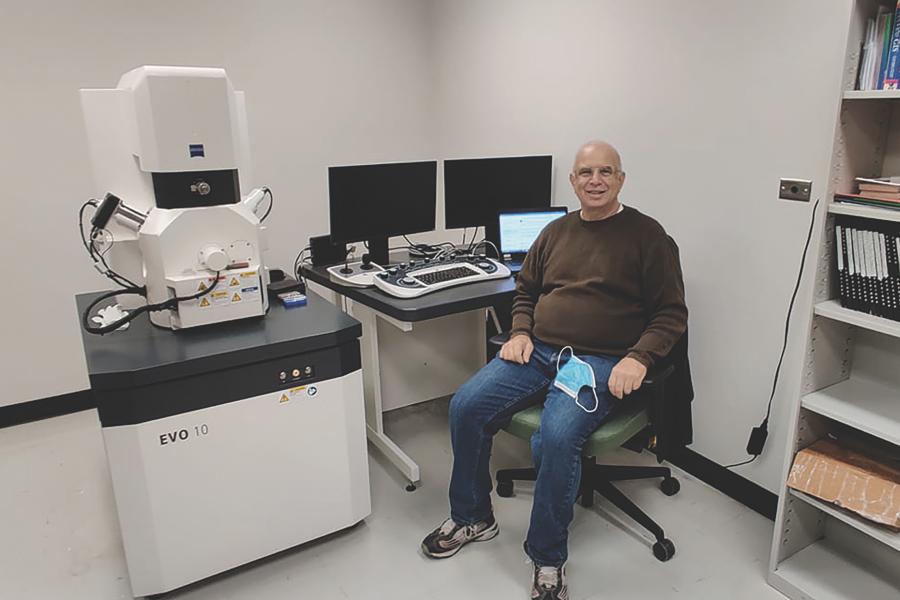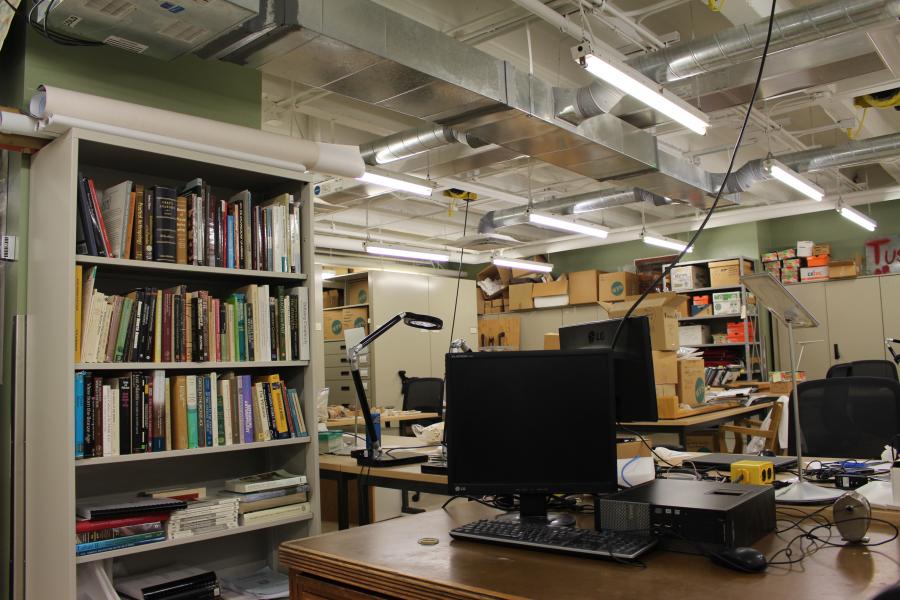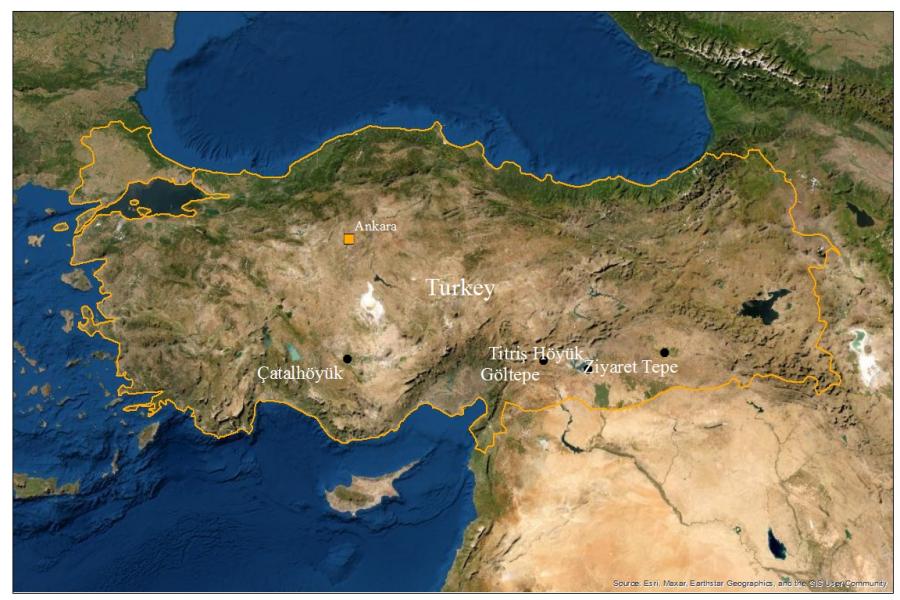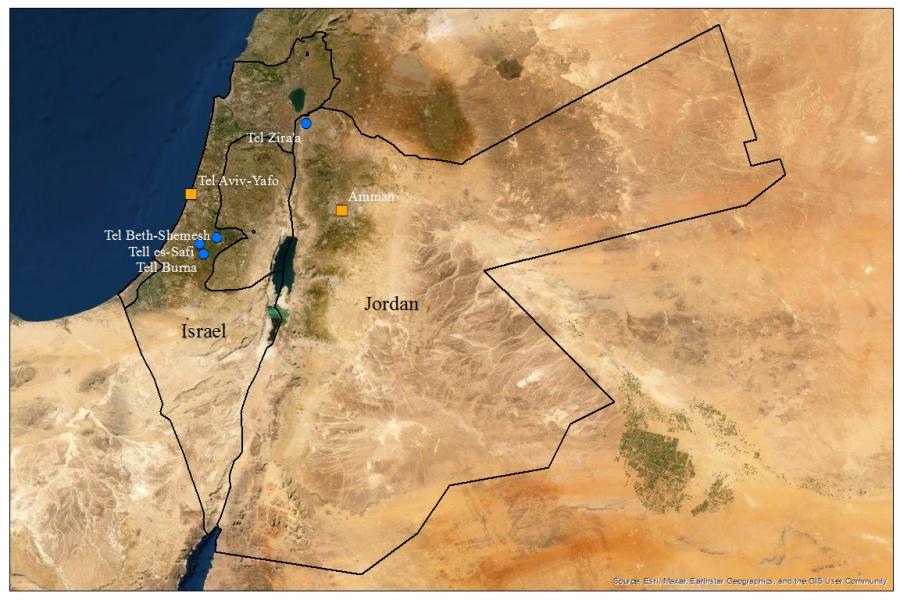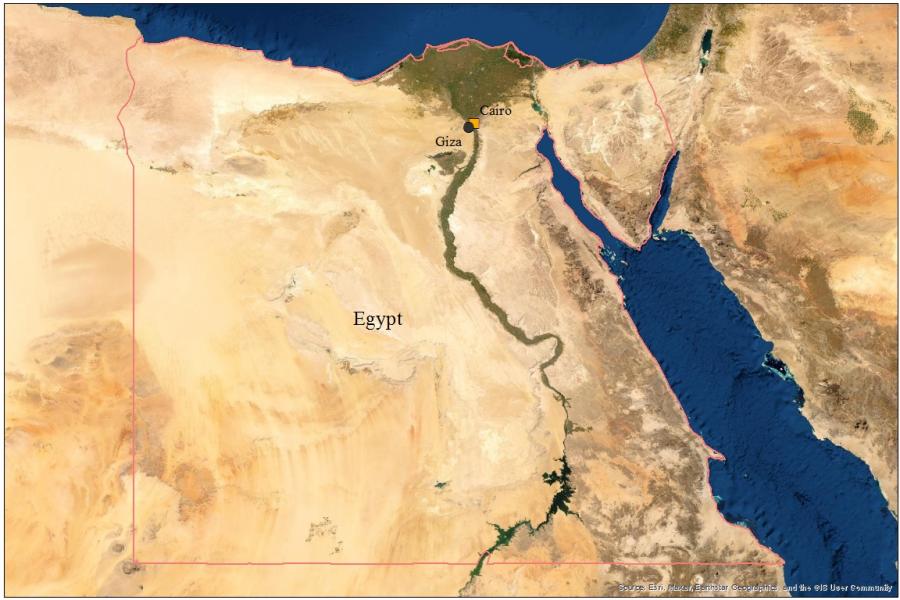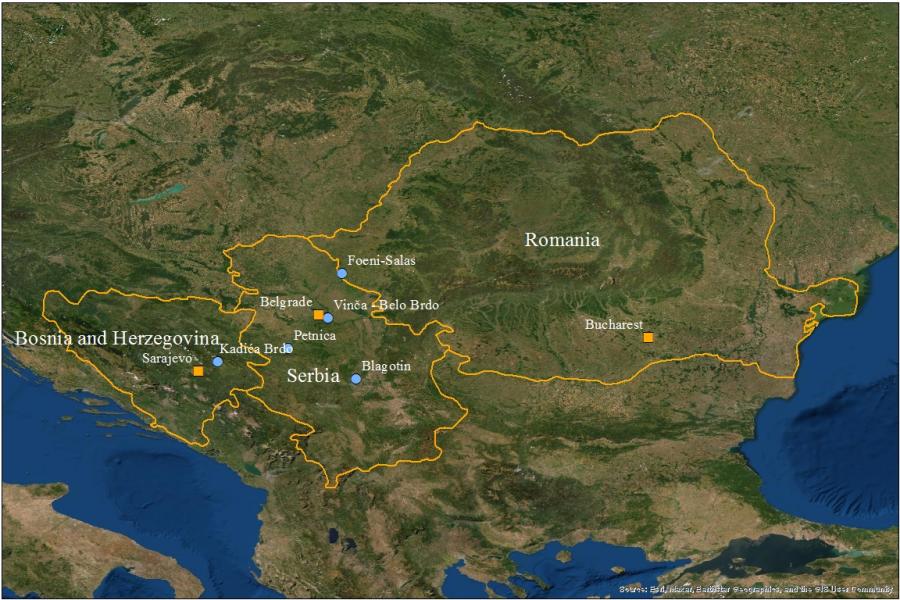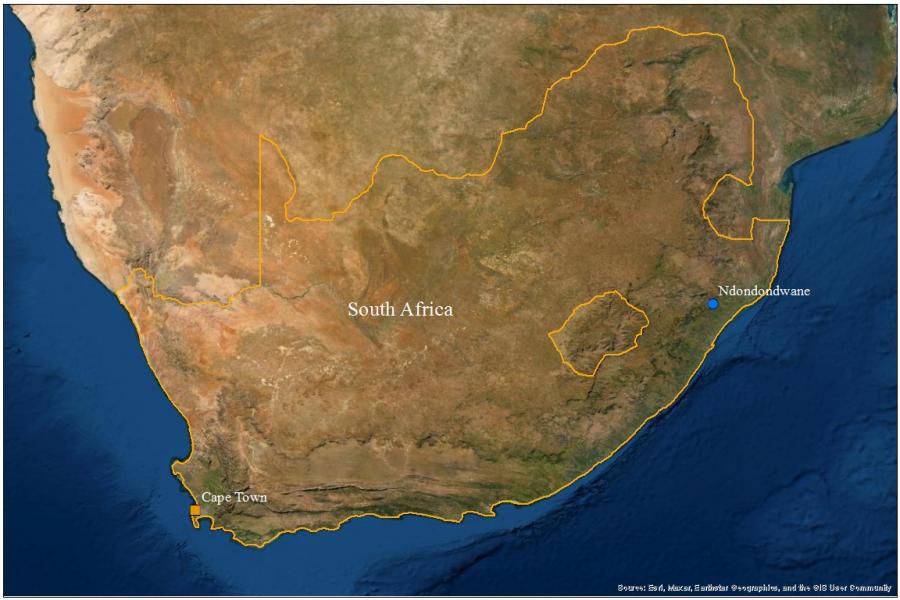Dr. Haskel J. Greenfield
Co-Director, Near Eastern and Biblical Archaeology Laboratory
University Distinguished Professor, Anthropology
144 St. Paul's College
204-272-1591
Haskel.Greenfield@umanitoba.ca (Preferred form of communication)

Researchers and Staff
-

-
-
-
Dr. Tina L. Jongsma-Greenfield
Co-Director, Near Eastern and Biblical Archaeology Laboratory
Research Associate, Anthropology
144 St. Paul's College
204-272-1591
Tlgreenfield@gmail.com (Preferred form of communication) -
Current Graduate Students
- Annie Brown
- Sarah Richardson
- Vahid Askarpour
- Mahyar Khademi Bami
Facility and Equipment
Maps of NEBAL archaeological sites
Near Eastern archaeological sites description
-
Some of the NEBAL research results for Near Eastern archaeological sites:
Tel Burna
The site of Tel Burna is located in the Shephelah region, which served as a border between the kingdoms of Judah and Philistia in the Iron Age. A fertile area that supported agricultural production, the region became known as the breadbasket of the south and as suggested before by some scholars. It is believed that the site is the best candidate for Biblical Libnah. The tel’s prominence is notable in its flat-topped shape, extensive size, and fortification which are still visible today. Survey finds from the 2009 season indicate that the city was an important entity in the Bronze and Iron Ages. Excavations have revealed settlements from the 7-9th and 13th centuries BCE, as well as some Persian period, remains. Excavations are ongoing. The excavations are directed by Professor Dr. Itzhaq Shai, Ariel University (Israel). Tina L. Greenfield (co-director of NEBAL) is the project zooarchaeologist, and she analyses the animal bone remains each summer in Israel and throughout the year in NEBAL. Every summer, she holds a field school where she welcomes students from all over the world, including those from Canada. Students from the University of Manitoba interested in joining the field school should contact Tina Greenfield or Haskel Greenfield
Tell es-Safi/Gath
The goal of the research at Tell es-Safi/Gath was to investigate the nature of neighbourhoods in early urban settlements that arose in the southern Levant (Israel, Jordan) during the Early Bronze Age (EBA, c. 3500-2100 BCE) through the application of the constellation of modern scientific analytical techniques. It investigated how the inhabitants of an early city organised their space and daily lives through the excavation of a non-elite residential neighbourhood, where the majority of people would have lived and worked. The project applied both traditional macroscopic and newer microscopic techniques for data collection and analysis in the investigation of this early urban neighbourhood. The various specialist perspectives were integrated into the field and lab work to create a synthetic perspective on how people lived in early city neighbourhoods. Specialists in archaeological zoology, paleobotany, radiocarbon dating, sedimentation, chemistry, phytolith, etc. jointly conducted and published research with the excavation team. This partnership of specialists was the first large-scale and systematic excavation of an EBA neighbourhood in the southern Levant to be scientifically excavated using cutting-edge modern excavation and analytical techniques. Incorporating data and analysis from a wide range of archaeological experts, vastly enhanced our understanding of early urban community lifestyles. This long-term research program was conducted in association with the Tell es-Safi/Gath Field School where students from all over the world receive intensive education in the archaeology of the region and archaeological methods. Haskel J. Greenfield (co-director of NEBAL) in partnership with Prof. Aren Maeir from Bar-Ilan University, Israel (Partner Institution) jointly directed the excavations of the EBA neighbourhood part of the site.
Various University of Manitoba faculty and students are involved in various aspects of the project. Haskel Greenfield (Distinguished Professor) is the co-director, and Tina Greenfield (Research Associate) is the project zooarchaeologist. Various students have received training on the site and used data for their theses: A Brown (Ph.D. student), Sarah Richardson (Ph.D. student), Jeremy Beller (MA 2014), Jon Ross (Ph.D. 2020), and others. Over 3 dozen undergraduate and graduate students participated through the years at the University of Manitoba’s Archaeological Field School at Tell es-Safi/Gath.
- The Telles-Safi/Gath Archaeological Project Official (and Unofficial) Weblog
- Tell-es Safi Early Bronze age Official website and blog of EBA excavations
- Spatial Representation of Heavy Fraction Collection and Analysis from Tell eṣ-Ṣâfi/Gath, Israel (PDF)The Manufacture of Early Bronze Age III Holemouth Jars and Platters from Tell es-Safi/Gath, Israel: An Examination of Shaping Techniques at the Mesoscopic Scale (PDF)
- Stones in homes: The spatial distribution and use of ground stone objects at EB III Tell es-Safi/Gath, Israel (PDF)
- Analysis of faience beads from Early Bronze Age contexts at Tell es-Safi/Gath, Southern Levant (PDF)
- 3D Geometric Morphometrics and Sheep/Goat Breeds in the Early Bronze Age of Tell es‐Safi/Gath (PDF)Production, Consumption And Disposal: A Consideration Of Spatial Variation In Faunal Distributions At Early Bronze Iii Tell Es-Safi/Gath, Israel (PDF)Sweating the small stuff: Heavy Fraction collection and analysis from Tell es-Safi/Gath (PDF)Spatial Representation of Heavy Fraction Collection and Analysis from Tell eṣ-Ṣâfi/Gath, Israel (PDF)
Göltepe
The site of Göltepe is an Early Bronze Age (3100-2100 BC) industrial/habitation site located in the high mountains of southeastern Turkey. It was excavated by K. Aslihan Yener in the 1990s. Göltepe is a small village estimated to be between eight to ten hectares. Radiocarbon dates from Göltepe range from 3290-1840 BCE, uncalibrated, which places it in the later Early Bronze Age. It is architecturally unlike any site in Turkey - the workshop/habitation units are ovoid semi-subterranean and fully subterranean pit structures, which are cut into the bedrock with smaller subsidiary bell-shaped pits in the association. Smaller houses measure 4-6 metres in diameter. Larger houses are 9x7 metres and are terraced off the slope. The superstructures of these units are wattle and daub. Postholes were found in some structures. Clay structural elements (geometrically designed panels) may have decorated the interior spaces of the pit structures or provided decorative borders for doors, bins, and altars (Yener and Vandiver 1993, Yener 2000). Göltepe is an early metallurgical production site that is in direct proximity to the only tin source in the Near East, the Kestel Tin Mine across the valley. Analysis of the metallurgical debris indicates intensive mining, smelting, and metal produced at the site was exchanged as far away as Mesopotamia.
Haskel J. Greenfield (along with students – Talisha Chaput and Tiffany Okaluk) is the zooarchaeologist for the project and is currently writing up the final report on the faunal materials. The analysis of the zooarchaeological remains allows reconstruction of the local food provisioning and subsistence systems and an examination of the types of raw materials (stone or metal) used to butcher and process the animals. So far, it appears that most of the meat on the bones was filleted with stone knives, while the heads were often chopped open with metal axes. This small site distant from most urban centres provides for an increased understanding of the relationship between the evolution of productive specialisation in metallurgy and the organisation of food production. Relatively little is known about the nature and structure of a community or household organization in such settlements since they were far from regions with historical texts. The zooarchaeological remains represent the first large (10,000+ fragments) sample from an Early Bronze Age context associated with metallurgical production. All bones are being analysed and curated in NEBAL. Excavations are completed at the site.
Titriş Höyük
The site of Titriş Höyük is an Early Bronze Age (c. 2500-2100 BCE) city located in southern Turkey, on a tributary of the Euphrates River. It was the capital of a small Early Bronze Age kingdom in the region. Several areas of the site were extensively excavated over 10 years (during the 1990s) by Prof. Dr. Guillermo Algaze, Dept. of Anthropology, University of California, San Diego. His excavations focused on two areas of the site to expose significant sections of neighbourhoods of domestic residences. Prof. Dr. Haskel Greenfield is the zooarchaeologist for the project and continues to analyse the animal bone remains from the site. Zooarchaeology is an extremely useful means for reconstructing differences in consumption patterns between neighbourhoods in early urban sites. It allows a comparative analysis of neighbourhoods, high versus low class, and public versus private areas in terms of food availability, consumption and discard. The results provide insights into the economy of the site and the nature of neighbourhoods in early urban environments. By implication, it will be able to address the nature of economic relations between different sectors of society. A comparison of data between neighbourhoods demonstrates that there is little evidence of social inequality between neighbourhoods concerning animal remains. (i.e. taxa, age, and body parts). While the architecture and artefacts from the excavation of the two neighbourhoods do not demonstrate significant differences between them in terms of wealth or status, the animal bones tell a very different story. They relate to what people were eating and how they organised food and other goods to provide for the city. Even though there is no evidence that domestic livestock was preferentially provisioned to consumers according to the neighbourhood in which they lived, the wild animals tell a very different story. The basic identification and analysis of the animal that remain from the site are completed and being prepared for final publication.
Ziyaret Tepe
Ziyaret Tepe is an archaeological site in southeastern Turkey, on the Tigris River, south of the city of Diyarbakir. The site is a very large tell site with a significant lower city that dominates the alluvial flood plain of the Tigris. It has an occupational sequence from the Early Bronze Age (c. 3000 BCE) to the Islamic and Medieval periods. The period of most intense occupation, when it spreads out from a small mound to a large city, was during the Neo-Assyrian occupation (c. 900-611 BCE). This was the period when the Assyrian empire expanded northwards and Ziyaret became a provincial capital along the northern rim of the empire. From contemporary cuneiform documents, we know that the site's ancient name as Tushan. It held out for a few years after Nineveh (the imperial capital) fell to the Babylonians in 612 BCE. Cuneiform texts, palaces, mansions, houses, storage facilities, extensive fortifications and many other parts of the site were investigated by survey and excavation from 1997-to 2013. The excavations were directed by Prof. Dr. Tim Matney (Univ. of Akron, OH, USA), with colleagues from Canada (Dr. Tina L. Greenfield), UK (Dr. John MacGinnis, University of Cambridge), Germany (Prof. Dr. Dirk Wicke, Goethe University, Germany), and Turkey (Prof. Dr. Kemallatin Korogulu, University of Mamara, Istanbul). Tina Greenfield (co-director of NEBAL) is the project zooarchaeologist. The faunal remains are curated in NEBAL and continue to undergo analysis and publication. Her work has already demonstrated the food was distributed in an organised fashion through central stores and that there were significant differences in food consumption between the upper and lower social strata at the site.
Recommended Courses
ANTH 2650 Arch. of the Ancient Near East
ANTH 1210 Human Origins & Antiquity
ANTH 2060 European Archaeology
ANTH 2100 Introduction to Archaeology
ANTH 2600 Old World Prehistory
ANTH 2610 Old World Civilization
ANTH 2820 Human Osteology
ANTH 2930 Archaeology of a Selected Area
ANTH 3910 Archaeological Field Training
ANTH 3950 Artifact Analysis
ANTH 3980 Botanical Analysis in Archaeology
ANTH 3990 Faunal Analysis in Archaeology
ANTH 4760 Practicum in Archaeology
T60 & 61 Summer Travel-Study Course
CLAS 2670 Greek Art and Archaeology
CLAS 2680 Roman Art and Archaeology
CLAS 3260 Hellenistic Civilization
CLAS 3650 Religion in Ancient Greece
CLAS 3660 Religion in Ancient Rome
HIST 1350 An Introduction to the History of Western Civilization
JUD 2650 Field Studies in Biblical Lands
For full course descriptions, please visit the Academic Calendar.
Field School
-
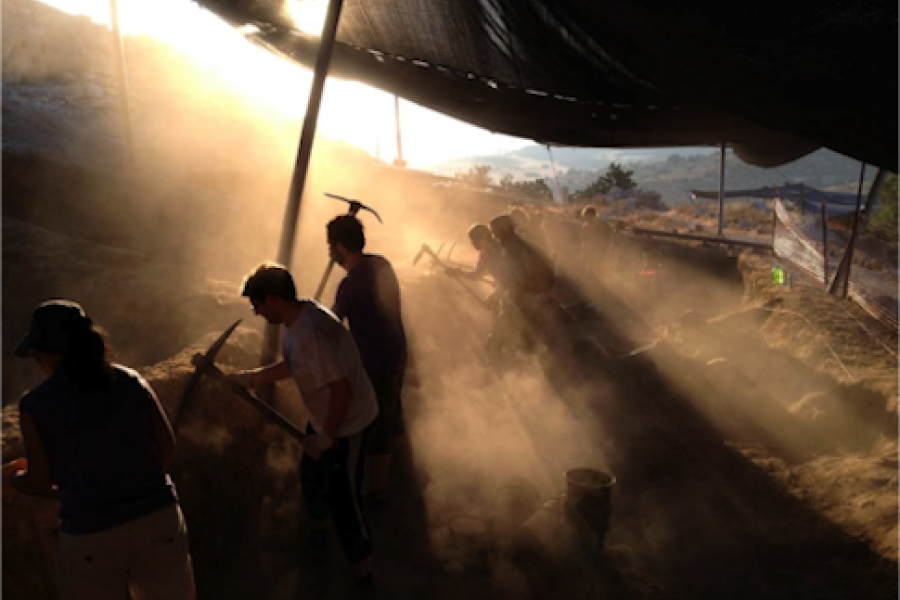
-
If you are interested in learning more about Field School opportunities or Laboratory experience please contact Dr. Haskel J. Greenfield at Haskel.Greenfield@umanitoba.ca
Support the Near Eastern and Biblical Archaeology Laboratory
Contributions to the Near Eastern and Biblical Archaeology Laboratory can be made online at CanadaHelps.org (St. Paul’s College Foundation Inc.); by contacting our Community Development Office at 204-474-9148 for Visa or Mastercard donations or by mail at St. Paul’s College Foundation Inc., Rm 213 – 70 Dysart Road. Please make your cheques payable to St. Paul’s College Foundation Inc.
Charitable number: 869-129-932 BN 0001
Donate online
Contact Us
Near Eastern and Biblical Archaeology Laboratory
144-70 Dysart Road
University of Manitoba
Winnipeg, MB R3T 2M6

